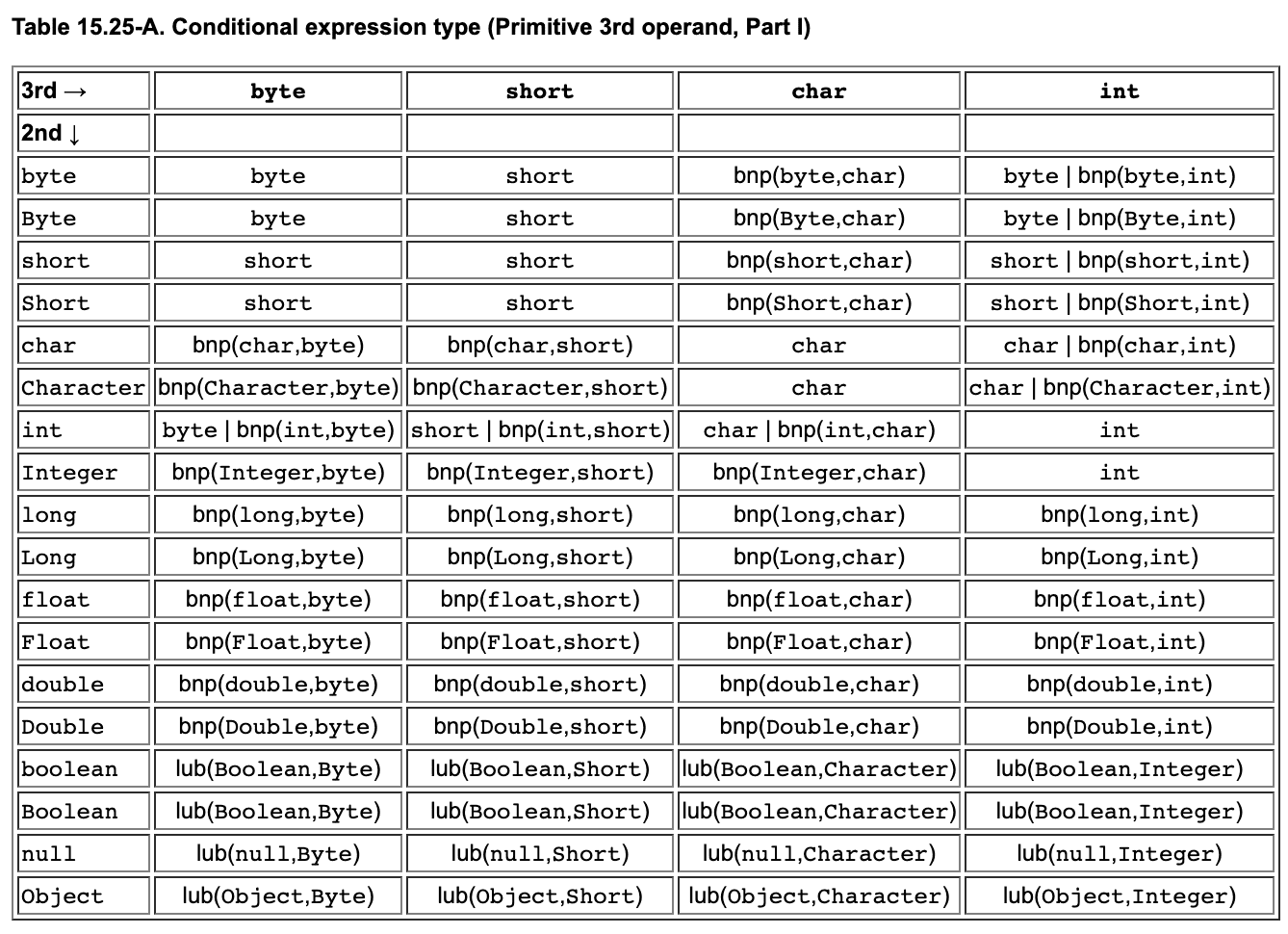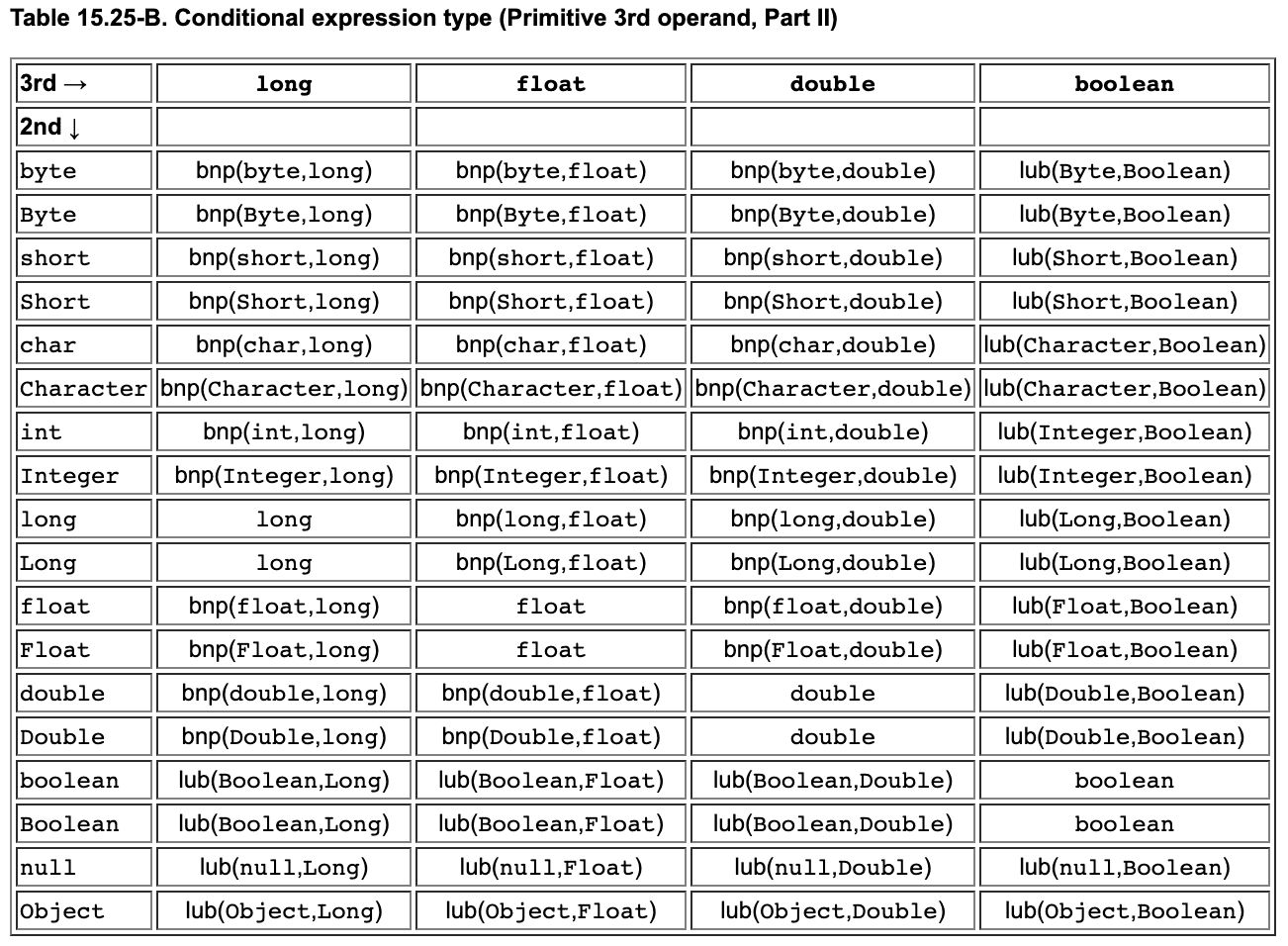Java의 삼항 연산자와 Null Pointer Exception
언박싱하다 NPE가 터지는 것이 원인
- 발단: 삼항 연산자 사용중 NPE 발생
- 용어: 삼항 연산자와 Conditional Operator
- 스펙 문서를 읽어보자
- 결론: NPE가 발생한 과정
- 문제가 발생하지 않게 하려면 어떻게 해야 할까?
- 부록 A. Java 13 스펙의 15.25 절
- 함께 읽기
발단: 삼항 연산자 사용중 NPE 발생
팀 동료가 삼항 연산자를 사용하다 NPE가 발생하는 문제를 경험하게 되어 기록한다.
동료가 사용한 Java 버전은 11이고, 내가 사용한 Java 버전은 13 이다.
그러나 Java 7 ~ 13 에 걸쳐 모두 나타나는 문제로 알고 있다. Java 6 이전은 잘 모르겠다.
다음 코드는 문제 상황을 단순하게 가공한 메소드이다.
Integer occursNullPointerException() {
boolean check = false;
Integer number1 = null;
Integer number2 = check ? 0 : number1; // NPE
return number2;
}
얼핏 보면 number2에 그냥 null이 대입되어, null을 리턴하게 될 것 같다.
그러나 이 메소드를 실행하면 삼항 연산자가 있는 라인에서 NullPointerException이 발생한다.
사실 이 문제는 자바 세계에서는 유명한 삼항 연산자 언박싱 문제이며, Java Language Specification을 보면 어렵지 않게 이해할 수 있다.
용어: 삼항 연산자와 Conditional Operator
문제를 이해하기 전에 먼저 용어에 대해 정리할 필요가 있다.
삼항연산자는 말은 항이 셋인 연산자라는 뜻이다.
따라서 ? :로 표현하는 연산자만을 지칭하는 단어가 아니다.
Java 8 Language Specification에서는 삼항 연산자를 Conditional Operator라고 부르고 있다.
번역하자면 조건 연산자라 할 수 있겠다.
그러므로 이 문서의 아래 부분부터는 삼항 연산자가 아니라 조건 연산자라는 표현을 사용하겠다.
스펙 문서를 읽어보자
Java의 언박싱 형변환
이 문제를 이해하기 위해서는 먼저 언박싱(unboxing) 형변환이 무엇인지에 대해 알아야 한다.
언박싱 형변환이 무엇인지를 알아보는 것은 쉽다.
Java 8 Language Specification 5.1.8. Unboxing Conversion에 심플하게 나와 있기 때문이다.
다음의 딱 8 가지 경우만을 언박싱 형변환이라 부른다.
- From type
Booleanto typeboolean- From type
Byteto typebyte- From type
Shortto typeshort- From type
Characterto typechar- From type
Integerto typeint- From type
Longto typelong- From type
Floatto typefloat- From type
Doubleto typedouble
(참고로 Java 7의 5.1.8 절 과 Java 13의 5.1.8 절을 비교해보면 바뀐 점이 전혀 없다.)
그리고 언박싱 형변환은 런타임에 다음과 같이 처리된다.
- If
ris a reference of typeBoolean, then unboxing conversion convertsrintor.booleanValue()- If
ris a reference of typeByte, then unboxing conversion convertsrintor.byteValue()- If
ris a reference of typeCharacter, then unboxing conversion convertsrintor.charValue()- If
ris a reference of typeShort, then unboxing conversion convertsrintor.shortValue()- If
ris a reference of typeInteger, then unboxing conversion convertsrintor.intValue()- If
ris a reference of typeLong, then unboxing conversion convertsrintor.longValue()- If
ris a reference of typeFloat, unboxing conversion convertsrintor.floatValue()- If
ris a reference of typeDouble, then unboxing conversion convertsrintor.doubleValue()- If
risnull, unboxing conversion throws aNullPointerException
여기에서 주목할 곳은 마지막 줄이다.
If
risnull, unboxing conversion throws aNullPointerException
번역하자면 다음과 같다.
만약
r이null이면, 언박싱 형변환은NullPointerException을 던진다.
만약 null을 언박싱 하려 하면 NPE가 발생한다는 뜻이다.
Java의 조건 연산자
이제 Java 7 Language Specification 15.25. Conditional Operator ? :를 읽어보자.
Java 8 스펙 문서를 먼저 읽지 않고 Java 7 스펙 문서를 먼저 읽는 이유는 7 스펙의 15.25절이 더 이해하기 쉽기 때문이다.
8 스펙 문서는 모든 경우의 수를 표로 정리해 두었기 때문에 읽기 좀 복잡하다. (궁금하다면 이 글의 부록 A를 읽어보자.)
이 부분을 읽을 때 주목할 점은 조건 연산자에 타입이 있다는 것이다.
즉 조건 연산자는 if와는 다르다. 결과가 특정 타입으로 평가되는 표현식인 것이다.
조건 연산자의 타입은 어떻게 결정되는가?
조건 연산자 표현식의 타입 결정 규칙은 스펙 문서에 잘 나와있다.
두 줄만 읽어보자.
- If the second and third operands have the same type (which may be the null type), then that is the type of the conditional expression.
- If one of the second and third operands is of primitive type
T, and the type of the other is the result of applying boxing conversion (§5.1.7) toT, then the type of the conditional expression isT.
번역해 보자면 다음과 같다.
- 두번째와 세번째 피연산자의 타입이 같다면(
null포함), 그 타입이 조건 표현식의 타입이다.- 만약 두번째와 세번째 피연산자 둘 중 하나가
T라는 primitive 타입이고, 다른 하나가T를 박싱 형변환한 결과라면, 조건 표현식의 타입은T이다.
즉, 다음과 같이 생각하면 된다.
check ? null : null이면 타입은null이다.check ? Double : Double이면 타입은Double이다.check ? Boolean : boolean이면 타입은boolean이다.check ? int : Integer이면 타입은int이다.
결론: NPE가 발생한 과정
스펙 문서는 충분히 읽었다. 이제 문제의 코드를 다시 살펴보자.
Integer occursNullPointerException() {
boolean check = false;
Integer number1 = null;
Integer number2 = check ? 0 : number1; // NPE
return number2;
}
조건 연산자의 타입은 Integer일까? 아니면 int일까?
primitive 0이 있으므로, 조건 연산자의 타입은 int가 된다.
따라서
- 조건절이
true이면int인0이 된다.- 아무런 예외가 발생하지 않는다.
- 조건절이
false이면Integer인number1을int로 언박싱한다.- 5.1.8 절에서 읽은 바와 같이
null을 언박싱 하는 것이므로NPE발생.
- 5.1.8 절에서 읽은 바와 같이
문제의 코드에서는 조건절이 false 였다.
그러므로 number1은 Integer에서 int로 언박싱되며, 다음 코드처럼 작동하게 된다.
Integer occursNullPointerException() {
boolean check = false;
Integer number1 = null;
Integer number2 = check ? 0 : number1.intValue(); // NPE
return number2;
}
그런데 number1이 null 이므로 NPE가 발생하게 된다.
문제가 발생하지 않게 하려면 어떻게 해야 할까?
그냥 if 문을 쓴다
if 문은 이해하기 쉽고 심플하다.
Integer getNumberWithoutNPE() {
boolean check = false;
Integer number1 = null;
if (check) {
return 0;
}
return number1;
}
조건 연산자의 타입을 맞춰준다
0을 Integer로 제공하면 조건 연산자의 타입이 Integer가 되므로 문제가 해결된다.
Integer getNumberWithoutNPE() {
boolean check = false;
Integer number1 = null;
Integer number2 = check ? Integer.valueOf(0) : number1;
return number2;
}
부록 A. Java 13 스펙의 15.25 절
위에서는 8 스펙 문서의 15.25 절을 읽지 않고 7 스펙 문서의 15.25 절만 살펴 보았다.
그러나 그냥 넘어가면 아쉬우니 읽어보도록 하자. 사실 핵심은 Java 7 스펙 문서와 달라진 것이 없고, 모든 경우의 수를 자세히 나열하고 있기 때문에 여기부터는 관점에 따라 불필요한 파고들기로 보일 수도 있다.
(참고로 Java 8 Spec의 15.25 절과 Java 13 Spec의 15.25 절은 딱 한 줄만 다르고 나머지는 모두 같다.)
13의 스펙 문서가 한 줄이 더 많으므로 8은 건너뛰고 13의 15.25 절을 읽어 보도록 하겠다.
조건 표현식 타입의 결정
조건 표현식의 타입을 결정하는 부분에 대한 이야기는 세 파트로 나뉘어 있다.
boolean표현식 파트numeric표현식 파트- 그 외의 경우 파트
- If both the second and the third operand expressions are boolean expressions, the conditional expression is a boolean conditional expression. For the purpose of classifying a conditional, the following expressions are boolean expressions:
- An expression of a standalone form (§15.2) that has type boolean or Boolean.
- A parenthesized boolean expression (§15.8.5).
- A class instance creation expression (§15.9) for class Boolean.
- A method invocation expression (§15.12) for which the chosen most specific method (§15.12.2.5) has return type boolean or Boolean.
Note that, for a generic method, this is the type before instantiating the method's type arguments.- A boolean conditional expression.
- If both the second and the third operand expressions are numeric expressions, the conditional expression is a numeric conditional expression.
For the purpose of classifying a conditional, the following expressions are numeric expressions:
- An expression of a standalone form (§15.2) with a type that is convertible to a numeric type (§4.2, §5.1.8).
- A parenthesized numeric expression (§15.8.5).
- A class instance creation expression (§15.9) for a class that is convertible to a numeric type.
- A method invocation expression (§15.12) for which the chosen most specific method (§15.12.2.5) has a return type that is convertible to a numeric type.
Note that, for a generic method, this is the type before instantiating the method's type arguments.- A numeric conditional expression.
- Otherwise, the conditional expression is a reference conditional expression.
내용은 많지만 7 스펙을 기억하고 있다면 어렵지 않게 이해할 수 있다. 요약하자면 다음과 같다.
- 두번째, 세번째 피연산자가 모두
boolean이면 조건 표현식의 타입은boolean이 된다. - 두번째, 세번째 피연산자가 모두
numeric타입이면 조건 표현식의 타입도numeric이다. - 그 외의 경우, 조건 표현식의 타입은 참조이다.
여기에서 경우의 수가 많이 나뉘는 곳은 numeric 타입에 대한 것이다. 그래서 모든 경우의 수가 테이블로 정리되어 있다.
이 표를 이해하려면 bnp와 lub가 무엇인지 먼저 알아야 한다.
BNP: Binary Numeric Promotion
bnp는 Binary Numeric Promotion를 말한다.
이 부분에서 Java Specification 문서는 BNP 에 대해 링크를 안 걸어놨기 때문에, 이 문서를 처음 본다면 당황할 수 있다. 그러나 다행히 링크만 안 걸려 있을 뿐이고 BNP 문서는 존재한다.
5.6.2. Binary Numeric Promotion 절이 있기 때문에 그걸 읽어보면 된다.
(참고로 Java 7 의 5.6.2 절과 Java 13의 5.6.2절은 단어 하나가 바뀌고, 잘못 쓰인 쉼표 하나가 빠진 것 빼고는 똑같다.)
앞 부분만 먼저 읽어보자.
When an operator applies binary numeric promotion to a pair of operands, each of which must denote a value that is convertible to a numeric type, the following rules apply, in order:
- If any operand is of a reference type, it is subjected to unboxing conversion (§5.1.8).
- Widening primitive conversion (§5.1.2) is applied to convert either or both operands as specified by the following rules:
- If either operand is of type double, the other is converted to double.
- Otherwise, if either operand is of type float, the other is converted to float.
- Otherwise, if either operand is of type long, the other is converted to long.
- Otherwise, both operands are converted to type int.
15.25의 표를 이해하기 위한 최소한의 bnp의 알고리즘은 다음과 같다.
- 모든 레퍼런스 타입은 먼저 언박싱 형변환을 한다.
- 그리고 다음 절차를 따른다.
- 피연산자 중 하나가
double이면, 다른 피연산자는double로 형변환된다. double이 아니라,float이라면, 다른 피연산자는float으로 형변환된다.float이 아니라,long이라면, 다른 피연산자는long으로 형변환된다.- 그 외의 경우에 두 피연산자는 모두
int로 형변환 된다.
- 피연산자 중 하나가
즉 일종의 우선순위이다.
double > float > long > int
가령 bnp(double, Float)이 있다면 다음의 절차를 거치게 된다.
bnp(double, Float)→bnp(double, float)→double
만약 bnp(Integer, Byte)가 있다면 다음과 같이 된다.
bnp(Integer, Byte)→bnp(int, byte)→int
LUB: Least Upper Bound
lub는 상속 계통에서 공통된 가장 가까운 조상 타입이다.
자세한 내용이 궁금하면 4.10.4. Least Upper Bound를 읽어보도록 하자.
표: 모든 경우의 수





예: 표를 읽는 방법

2번째 항이 byte이고 3번째 항이 short 이면?
- 표에서 다음과 같이 찾는다.
- 즉
check ? byte : short의 타입은short이다.
- 즉

2번째 항이 int 이고 3번째 항이 long 이면?
- 표에서 찾아보면…
bnp(int, long)이다.bnp규칙에 따라bnp(int, long)→long이다.
2번째 항이 Long 이고 3번째 항이 float 이면?
- 표에서 찾아보면…
bnp(Long, float)이다.bnp규칙에 따라bnp(long, float)→float이다.

2번째 항이 int 이고 3번째 항이 byte 이면?
- 표에서 찾아보면…
byte | bnp(int, byte)이다.- 한 눈에
byte | int라는 것을 알아볼 수 있다. - 즉,
byte로 표현 가능한 값이면byte, 그렇지 않다면int가 된다는 뜻이다.
- 한 눈에
함께 읽기
- [[/java/use-java-primitive-type-for-performance]]{Java Autoboxing 자동 변환 주의점}